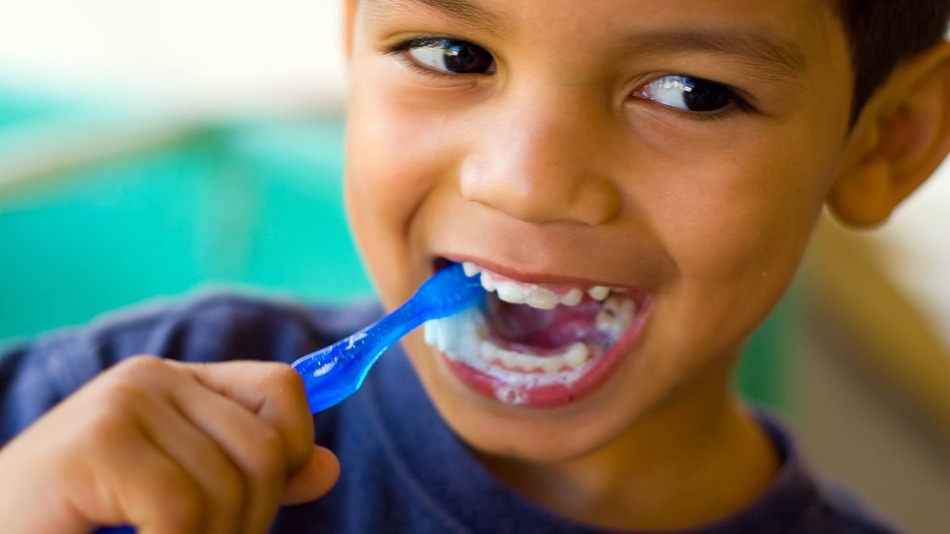
by Roseman Dental | Feb 1, 2016 | Dental Clinic Blog, Oral Health, Roseman Dental - NV, Roseman Dental - UT
Most children develop their first set of primary teeth (“baby teeth”) around 6 months of age and continue growing teeth until they are around 3 years old. While these teeth are not permanent, they are an important part of oral development, acting as placeholders to keep permanent teeth inside the gums until they are ready to erupt at the appropriate age.
February is Children’s Dental Health month, and developing good oral health habits and getting proper dental care, even at a young age, can significantly improve a child’s overall health. As parents, it’s important to help children get appropriate dental care at an early age, and develop good lifelong oral health habits.
The Effects of Poor Oral Health on Children
A healthy mouth allows children to speak, smile, chew, taste, and swallow properly, while and unhealthy mouth can lead to gum disease, pain, difficulty concentrating, school absence, early tooth loss, and eventually even chronic health problems. It is estimated that as many as 17 million children suffer from untreated tooth decay, making it the single most common chronic childhood disease in the U.S. According to the CDC, tooth decay affects more than 25% of U.S. children ages 2-5, and 50% of children ages 12-15, costing billions of dollars every year. Fortunately all of these things are preventable with some simple strategies for good oral health care that parents can do, and teach children as well.
Visit the Dentist Early and Often
Your child’s first dental visit should occur when s/he first develops teeth, and certainly no later than his/her first birthday. Even though children don’t have all their teeth by this time, seeing a pediatric dentist early can help parents learn proper oral care strategies for each critical stage of a child’s development. Continue seeing the dentist for check-ups every 6 months, or more often based on the advice of your dentist. You can also bring your child to The Dental Clinic at Roseman University for our annual Give Kids a Smile® event, where we offer free dental exams, cleaning, and x-rays, plus a $50 voucher to each child to attends, which can be used at the Dental Clinic for future treatment.
Brush and Floss Daily
Parents should clean children’s teeth starting when the first teeth appear through the gums. In the early stages of tooth development, you can use a clean washcloth with water or moist piece of gauze to wipe down the gums and teeth twice a day to prevent plaque. As more teeth develop, use a child-size toothbrush with soft bristles, and about half of a pea-sized amount of toothpaste specially formulated for children at least twice a day. Try to floss once a day as well. When children are old enough to begin brushing teeth on their own, supervise the process to ensure that children clean all their teeth adequately, and that they do not swallow toothpaste (especially if it contains fluoride).
Get Sealants
Sealants are a small plastic coating applied to a child’s teeth to prevent tooth decay and cavities by keeping food and germs out of the grooves of teeth. They are most often applied to molars (which develop between the ages of 6-12), and can be applied quickly during a regular check-up or cleaning. They usually last between five and 10 years, and can be reapplied if they break or fall out.
Use Fluoride
Fluoride is a mineral that helps strengthen tooth enamel by making it more resistant to attacks from plaque bacteria and sugar in the mouth, which cause decay. Fluoride can occur naturally in water and foods, but if there is not enough fluoride in your area, you may need to supplement your child’s intake with toothpaste, drops, or tablets, based on the advice of your dentist. However, ingesting too much fluoride can be toxic for children, so be sure to follow the advice of your dentist on how much fluoride is enough, and supervise children whenever they are brushing with fluoride toothpaste to ensure they spit it out.
Eat Healthy Meals
Nutritious foods, such as vegetables, fruits, protein, and whole grains can contribute to a healthy mouth, while unhealthy foods, especially those high in sugar, can lead to tooth decay and other chronic health conditions. Limiting the amount of sugar children eat, such as candy and sugary drinks, can also help avoid early tooth decay.
by Roseman Dental | Jan 27, 2016 | Dental Clinic Blog, Oral Health, Roseman Dental - NV, Roseman Dental - UT
There are many worthwhile resolutions to set for the New Year, but if you have always set a goal to be healthier there is something you should know: good dental health can help with your overall health. You will thank yourself in the future for making your mouth a priority, so to help you in your efforts, consider the following goals.
Brush and Floss Twice a Day
Good teeth are often the result of good oral hygiene. It is important to brush and floss twice each day to prevent gum disease and decay. You should also change your toothbrush a few times each year.
Use Fluoride
It is also smart to look for toothpastes and mouth rinses that contain fluoride. This can strengthen the enamel on your teeth. However, it should be used sparingly, especially in young children.
Rinse After Eating
Rinsing your mouth with water or brushing your teeth after meals is a great habit that can promote oral health. Rinsing your mouth can minimize bacteria and help prevent gum problems.
Choose the Right Foods
The foods you eat can also improve your oral health. There is research that indicates that omega-3 fats strengthen your gums and reduce disease. It is also a good idea to eat a well-balanced diet that is filled with protein (lean meats), grains, vegetables, fruits, and dairy products. In addition, try to avoid consuming too much sugar as an abundance of sugar can cause the enamel on the teeth to decay.
Get Regular Checkups
Regular appointments with a dentist can also help you prevent oral health issues and care for your teeth. If you have young children, make sure they visit the doctor early. In most cases, every six months is appropriate for a checkup. However, people with gum disease should see the dentist more often.
Make these goals a part of your 2016 New Year’s Resolutions. By following them, you can promote oral health and enjoy a beautiful smile.
by Roseman Dental | Jan 15, 2016 | Dental Clinic Blog, Oral Health, Roseman Dental - NV, Roseman Dental - UT
When it comes to the health of your teeth and gums, you may just think that as long as you brush and floss every day your mouth will be perfectly healthy. However, you also need to maintain a healthy diet to keep your pearly whites in pristine condition. Something that should absolutely be part of a balanced diet is folic acid, also known as Vitamin B9, and without it, you could be facing some serious health risks.
Gum Disease
Folic acid assists with cell repair, so if you are at risk of developing gum disease, then it can help combat the disease by helping repair the cells in your gums. A surprising number of Americans (almost 50 percent) have some form of gum disease, whether it is gingivitis or periodontitis, so Vitamin B9 should be taken daily. Folic acid is water soluble, meaning it cannot be stored in the body, so you need to consume some every day in order to take advantage of the benefits.
Birth Defects
Although more research needs to be done, many experts believe there is a link between pregnant women who do not take enough folic acid and the presence of certain birth defects such as cleft lip or cleft palate. These issues can necessitate speech therapy or surgeries later in life, so many dental professionals recommend pregnant women err on the side of caution and take in plenty of Vitamin B9 during their pregnancy.
It is fairly easy to consume enough folic acid to avoid these issues. It can be found in numerous food sources, including:
- Broccoli
- Sunflower seeds
- Spinach
- Beans
- Romaine lettuce
- Peanuts
- Asparagus
- Beets
Additionally, folic acid can also be found in numerous fortified breads and grains, so you can also get it through cereal or pasta. To make sure you are getting enough, check food labels to see how much you are getting in a single serving. It is an important vitamin, and you should take enough in your day-to-day life.

by Roseman Dental | Jan 7, 2016 | Dental Clinic Blog, Oral Health, Roseman Dental - NV, Roseman Dental - UT
If you’re like most people, the coming of a new year is a time to think about making new year’s resolutions for a healthier, happier you. If you’re tired of making—and breaking—the same resolutions to save money, get more organized, or lose weight, think about these four simple resolutions you can make for a healthier mouth, which can lead to better overall health.
Eat More Fruits and Veggies
If this sounds like a resolution for weight loss, consider that eating more fruits and vegetables, and a healthier diet all around, can help you lose weight at the same time that it improves your oral health. Nutrients in fruits and vegetables help to build your immune system, improving your ability to fight off infection like gum disease, inflammation, and bacteria in your mouth. Raw, crispy fruits also help reduce plaque buildup on the teeth, leading to fresher breath and fewer cavities. As a bonus, it will also help you work toward that other weight loss resolution.
Quit Smoking
Smoking is one of the main causes of oral decay, including tooth discoloration, cavities, receding gums, infection, and lung and oral cancers. Both cigarettes and smokeless tobacco can double your risk of losing your teeth, but fortunately once you stop smoking, the risk of tooth loss and other diseases immediately decrease.
Start Flossing
If you think your mouth is healthy because you already brush twice a day, it could be a lot healthier if you add flossing to that routine. Flossing helps remove hard-to-reach plaque that builds up between teeth and near the gum line, where you toothbrush can’t reach, and where gum disease often begins. It only takes 2 minutes to floss your teeth, so if you add that to your 2 minutes of brushing in the morning and night, you’re still spending less than 10 minutes a day to get a healthier mouth.
Go See a Dentist
There is no substitute for seeing your dentist regularly for cleanings and check-ups. If you haven’t been to the dentist in a while, make a new year’s resolution to schedule an appointment. Your dentist can help you identify and prevent oral health problems before they become major issues, and may notice subtle signs of disease that you would otherwise not see on your own. There are affordable places you can go for dental care, including the Dental Clinic at Roseman University, if you don’t have a dentist or you can’t afford to go to the dentist because you don’t have insurance.
by Roseman Dental | Dec 16, 2015 | Dental Clinic Blog, Oral Health, Roseman Dental - NV, Roseman Dental - UT
Everyone wants to have a healthy mouth and beautiful smile, but what exactly does it mean to have good oral health? Some individuals may think that a beautiful smile can be attributed to healthy teeth, but in some cases teeth whitening products can make a smile appear healthy even when it is not. If you are not certain what it means to have good oral health or what steps you should take to improve the health of your mouth, here is a brief definition of what you should be focused on.
Oral Refers to the Entire Mouth
The word “oral” has Latin roots that refer to the entire mouth; not just the teeth. This means that a person who wants to improve their oral health should focus on all of the tissues in the mouth, including the tongue, chewing muscles, teeth, gums, lips, and connective tissues. Based on this definition, oral health is achieved when all of the various structures in the mouth are taken care of and are free from painful conditions.
In addition to gingivitis and tooth decay, other conditions that affect oral health include:
- Soft tissue lesions in the mouth area
- Pharyngeal and oral cancers
- Cleft palate
- Cleft lip
- Other painful oral diseases or conditions
Why Oral Health Is So Important
The health and scientific communities are continuously discovering links between oral health and other dangerous physical conditions, such as:
- Premature births
- Stroke
- Heart disease
- Lung disease
If you are concerned about the health of your body in general, you should also be concerned about improving your oral health. In addition to being linked to various physical ailments, poor oral health can also make it difficult for individuals to participate in daily activities, such as eating, drinking, and conversing with others.
Improve Your Oral Health Today
You can take matters into your own hands and improve your oral health by regularly brushing and flossing your teeth, rinsing your mouth with mouthwash, eating a healthy diet, and receiving regular dental checkups.
by Roseman Dental | Dec 10, 2015 | Dental Clinic Blog, Dental School, Oral Health, Roseman Dental - NV, Roseman Dental - UT
Whether you specialize in pediatric dentistry or want to make sure your family practice is child-friendly, it’s important to have a wide repertoire of techniques at your disposal to calm children when they are having dental work done. You may even find that some of these techniques also work for skittish adults.
Engage and Educate
Although it isn’t necessary to turn your entire waiting area into a playroom, having activities that engage children while they wait for their appointment can go a long way toward keeping the anxiety at bay prior to their appointment time. You can choose to go the educational route, and use the waiting time as an opportunity to explain some things about the visit and their teeth and what to expect during their appointment, or you can provide movies, games, and toys.
Communicate
It’s important to address fears children might have by allowing them to talk about those fears, and by letting them know what to expect. Fully explaining what will happen during the visit gives them the opportunity to ask questions and can ease some of the fear of the unknown. Make sure they have a way to communicate with you throughout the procedure, or check in with them periodically to let them know how much longer they’ll be in the chair.
Involve Parents
Sometimes just the presence of a parent or familiar face in the exam room may help the child feel more safe and comfortable, especially if it’s their first time. Collaborating with the parent to demonstrate what will happen during the visit is an excellent strategy. You can explain to the child what will occur, demonstrate it on the parent, and then do the procedure with the child.
Parents also have a role in ensuring that children see the dentist for the first time at an early age (preferably by the time they turn 1) so children can have positive experiences from the beginning and learn that the dentist is not a place they should fear. If parents wait until a child requires extensive treatment, visits to the dentist will likely be viewed as fearful or painful events.
Using some or all of these techniques should help children manage their anxiety at the dentist. Doing so can visit more productive and enjoyable for everyone.




